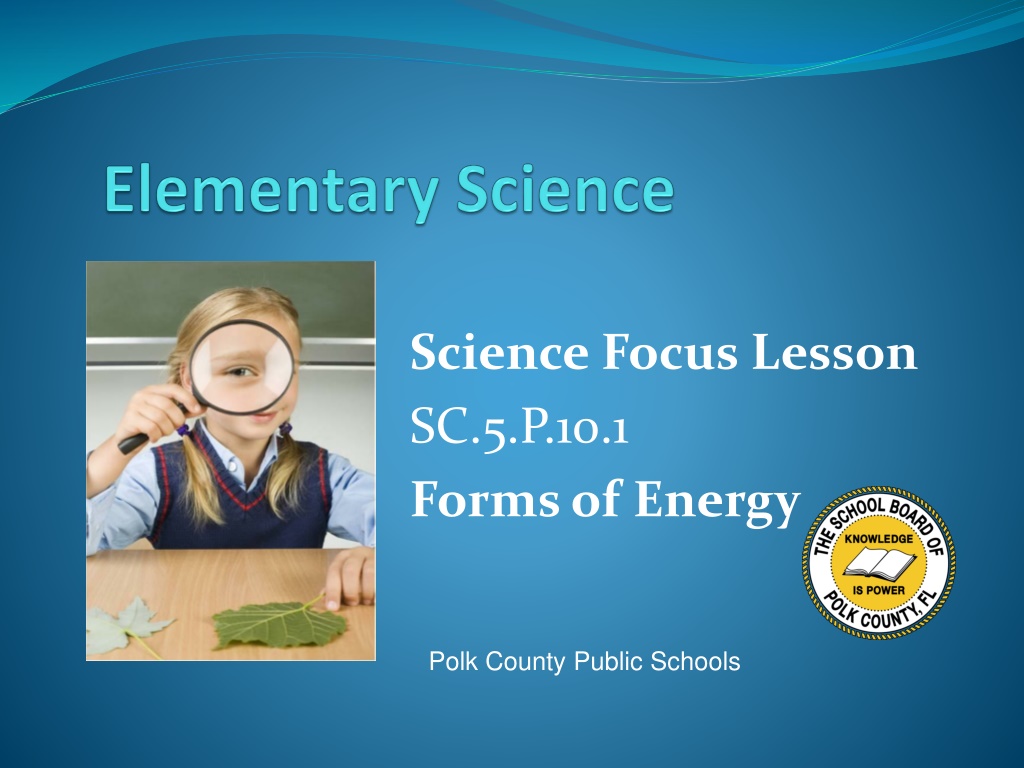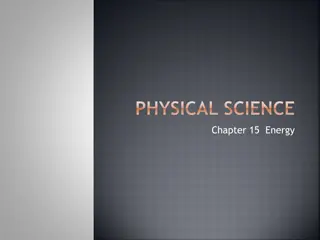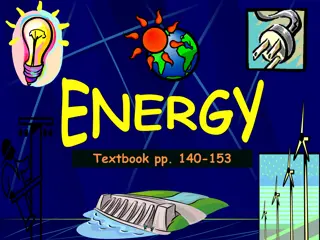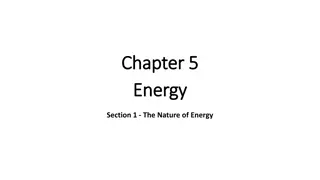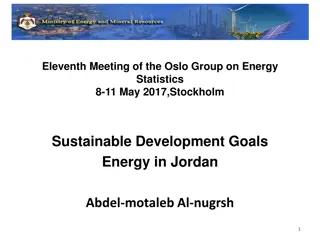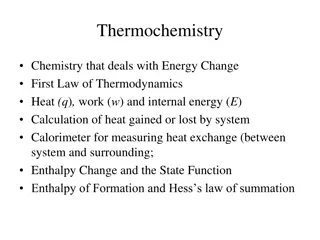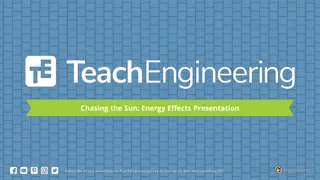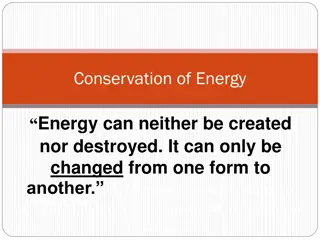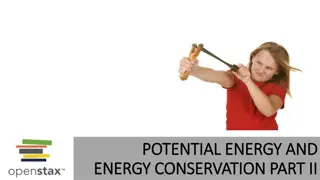Understanding Basic Forms of Energy
Energy exists in various forms such as light, heat, sound, electrical, chemical, and mechanical. These different forms of energy play a key role in causing changes in matter and enabling movement in various objects. From mechanical energy related to motion and position to chemical energy stored in materials like food and fuels, each form serves unique purposes in nature and human activities.
Download Presentation

Please find below an Image/Link to download the presentation.
The content on the website is provided AS IS for your information and personal use only. It may not be sold, licensed, or shared on other websites without obtaining consent from the author. Download presentation by click this link. If you encounter any issues during the download, it is possible that the publisher has removed the file from their server.
E N D
Presentation Transcript
Science Focus Lesson SC.5.P.10.1 Forms of Energy Polk County Public Schools
SC.5.P.10.1 Benchmark: Investigate and describe some basic forms of energy, including light, heat, sound electrical, chemical, and mechanical. Essential Question: What are some basic forms of energy? Vocabulary: energy light energy heat(thermal) energy sound energy electrical energy chemical energy mechanical energy
ENERGY Energy the ability to cause changes in matter A moving car has energy. The race car s engine changes the energy stored in gasoline into movement. The car moves because one form of energy changes into another. A boy riding a bike has energy. The boys muscles supply the energy to pedal the bike. Moving the pedals makes the bike move. A baseball player has energy. He must get energy inside his body from the food he eats to be able to hit the ball. A water wheel has energy. The moving water supplies the energy to turn the water wheel.
BASIC FORMS OF ENERGY Energy comes in many forms. Electrical Energy is the energy produced when electrons move from one place to another place. The movement of electrons is electricity. Electrical charges can turn on lights, cool your home, and allow your TV to turn on.
BASIC FORMS OF ENERGY Mechanical Energy is the energy an object has because due to its motion or due to its position. When work is done on an object, that object gains energy. The energy acquired by the object on which work is done is known as mechanical energy.
BASIC FORMS OF ENERGY Chemical Energy is the energy stored in materials such as food and fuels. Chemical energy is the result of atoms and molecules interacting. Plants use the energy in sunlight to make food. In the process, the sun s light energy is changed to chemical energy. Some of the chemical energy is stored in the plant. Animals that eat the plants take in this chemical energy and animals that eat plant-eating animals also take in the chemical energy. You and other animals use this energy to stay alive.
Summarize Partner A: Tell your shoulder partner what ENERGY is. Partner B: Tell your shoulder partner the 3 different forms of energy you reviewed and give examples of each.
BASIC FORMS OF ENERGY Heat Energy (also called thermal energy) is the energy of moving particles. Moving particles have energy. Particles in the pot move faster then the particles in water move faster. The more the water particles are heated, the faster they move. Heat energy can be produced in different ways. All of these ways change another form of energy into heat energy. The energy of motion can produce heat energy. Heat is produced when two objects are rubbed against each other.
BASIC FORMS OF ENERGY Light Energy is the energy that travels in waves. Light travels in a straight line until it strikes and object or travels from one material to another. When light passes from one object to another, light changes direction slightly. This is called refraction. If you shine light on a surface, some of that light will bounce off, or be reflected by, the surface. This process is called reflection. Light can be taken in by an object. This means it is absorbed. Most objects absorb some colors of light. Only clear objects transmit the light that hits them.
BASIC FORMS OF ENERGY Sound Energy is the energy carried by sound waves which are produced when an object vibrates. The different vibrations that cause these sounds are carried by sound waves with different characteristics. The pitch of a sound is how high or low the sound is. When vibrations are short the pitch is high. When vibrations are long, the pitch is low.
Summary With your shoulder partner, have a discussion about the following: Discuss these three words associated with light: reflect, refract, absorb Discuss the difference between low pitch and high pitch Identify and give examples of the all the forms of energy we reviewed this week
Guided Practice Work with your shoulder partner to answer each question 1. Melissa s school rings a bell to alert students that it is time to start class. When the bell rings, it vibrates. The use of vibrations to send messages is an example of which type of energy? A. chemical B. heat C. light D. sound
D is the correct answer! Sound An understanding of types of energy is needed to answer this question. Sound is a form of energy that travels in waves. When the bell vibrates, it produces sound waves.
Guided Practice 2. For a special dinner, Catherine s mom lit some candles in the living room for decoration. What two forms of energy does the fire from a burning candle release? A. light and heat B. sound and chemical C. magnetic and nuclear D. electrical and mechanical
A is the correct answer! Light and Heat
Guided Practice 3. Tanisha built the circuit in the picture below using a battery, insulated copper wire, and an iron nail. The iron nail has become magnetized by the battery and is attracting a metal paper clip. Which form of energy caused this nail to become magnetized? A.heat B. light C. electrical D. mechanical
C is the correct answer! Electrical
Summary With your shoulder partner, find some sources of energy in your classroom. Name the sources you find and what form of energy it creates. If time, share with the class.
Check Your Understanding Record your answers. Check them at the end. 1. There is only one fish in the fishbowl below. When Joseph looks down at the fish, the image he observes is closer to the surface than the actual location of the fish. Which wave characteristic does Joseph s observation demonstrate? A. absorb B. diffract C. reflect D. refract
Check Your Understanding 2. Sam wanted to make some pasta. He put water in a pot and put it on the stove. Soon the water was boiling. Sam added the pasta to the boiling water. What kind of energy caused the water to boil? A. Electrical energy B. Thermal energy C. Sound energy D. Chemical energy
Check Your Understanding 3. Several students were playing kickball. Fran gave the ball a hard kick. The ball went flying through the air. The moving ball contains which type of energy? A. Mechanical energy B. Chemical energy C. Heat energy D. Sound energy
Check Your Understanding 4. Max wanted to know if a light bulb got hot when it was lit. He decided to do an experiment. He got a thermometer and a lamp. He recorded the air temperature near the unlit bulb. Then he turned on the lamp. He carefully held the thermometer near the bulb. Which of the following will most likely happen to the air temperature near the lit bulb? A. The heat from the lit bulb will lower the air temperature. B. The heat from the lit bulb will raise the air temperature. C. The temperature will stay the same. D. The thermometer will get too hot and break.
Check Your Answers 1. D 2. B 3. A 4. B
Summary Write a summary paragraph explaining different forms of energy. Include extra information about light(reflect, refract, absorb) and sound(pitch).
